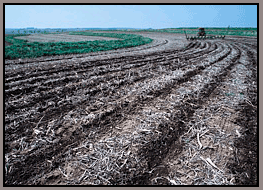
 A potential source of error in calculating soil carbon budgets has been identified by scientists at the U.S. Department of Agriculture (USDA).
A potential source of error in calculating soil carbon budgets has been identified by scientists at the U.S. Department of Agriculture (USDA).Agricultural Research Service (ARS) soil scientist Hero Gollany has used these findings to refine methods for assessing farming practices that retain carbon in the soil and thus mitigate carbon emissions that contribute to global climate change. ARS is USDA's chief intramural scientific research agency, and these findings support the USDA priority of responding to climate change.
Rates of soil carbon retention, known as sequestration, are often measured and estimated by tracking changes in total soil carbon over time. Carbon from crop residues or other decaying plant material is present in soil samples collected for these sequestration studies. But this "accrued" carbon is not actually sequestered in the soil until after the carbon becomes attached to soil mineral particles, a process that can take several decades.
Until that happens, the accrued carbon from decomposing plant material can readily be lost from the soil, because it is not bound or associated with soil particles. Inadvertently adding the accrued carbon to measurements of sequestered carbon results in overestimates of how agronomic practices affect sequestration levels.
Gollany and Washington State University soil microbiologist Ann-Marie Fortuna used data from another soil carbon field study to see how levels of a specific type of carbon called "light-fraction" carbon affected measurements. Using this method, the scientists determined that carbon sequestration levels measured in the study included carbon from fine crop residue materials that passed through sieves during sample processing-carbon that had accrued in the soil, but was not yet sequestered via decomposition.
This accrued carbon ranged from 13 percent to 19 percent of the total soil carbon in the samples. This, in turn, skewed attempts to use carbon data from the samples to model soil carbon sequestration levels.
Gollany, who works at the ARS Soil Conservation Research Unit in Pendleton, Oregon, published her findings in 2013 in the Soil Science Society of America Journal.
Read more about this work in the July 2014 issue of Agricultural Research magazine.
7.7.2014